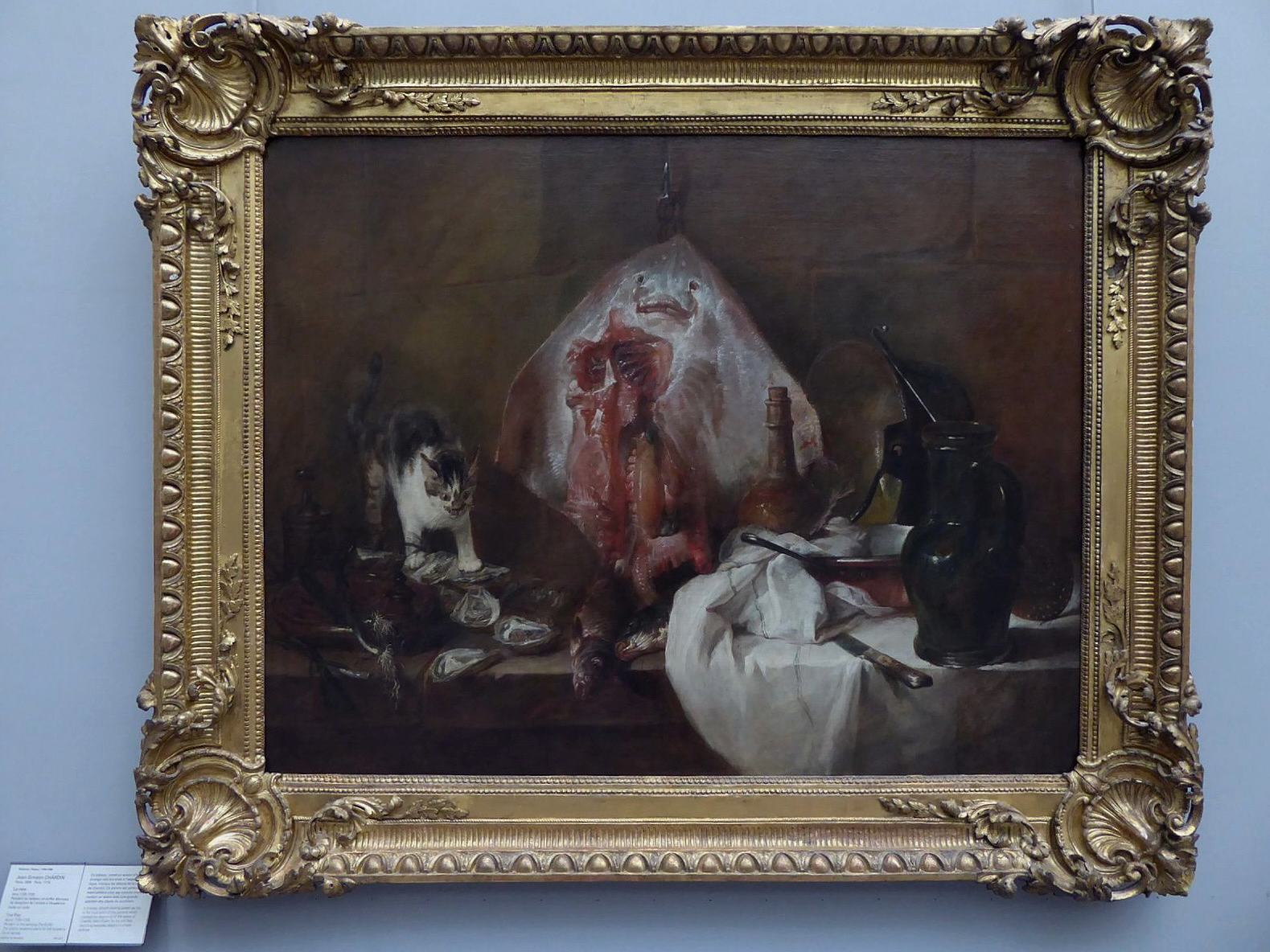
Jean Simeon Chardin (France, 1699-1779)
La raie (The Ray)
oil on canvas
114 cm × 146 cm (45 in × 57 in)
painted in 1728
Collection of Louvre Museum, Paris, France
![Jean Simeon Chardin (France, 1699-1779)
La raie (The Ray)
oil on canvas
114 cm × 146 cm (45 in × 57 in)
painted in 1728
Collection of Louvre Museum, Paris, France
At the Louvre, there's an enigmatic smile that's almost as successful as the Mona Lisa: Chardin's Stingray.
In 1728, Chardin achieved the feat of seducing the Académie Royale, which inducted him the very same day! The painting, immediately donated by the painter to the Académie Royale, was one of the first to enter the Louvre, where it remains to this day.
The painting fascinated artists. Diderot proposed it as a model for all painters. Proust describes it succinctly:
"But above you a strange monster, still fresh as the sea where it undulated, a ray is suspended, whose sight mingles with the desire of greed the curious charm of the calm or the storms of the sea of which it was the formidable witness. You can [...] already feel the freshness of the oysters that are about to wet the cat's paws, and you can already hear, at the moment when the precarious pile of these fragile mother-of-pearl bends under the cat's weight, the little cry of their crack and the thunder of their fall".
Painters such as Boudin and Matisse would go on to produce their own versions.
Why such success? For a start, this still life isn't quite a still life, with a cat to the left of the stingray, ears back, tail erect and hair bristling. And then there's the strength of the canvas's construction: a pyramidal composition that symmetrically arranges living elements around the central ray - the cat, oysters and fish - on the left, and objects, kitchen utensils, on the right. The knife, precariously balanced on the front of the table, evokes the vanitas, the still lifes that remind us of the fragility of life on earth.
And this stingray, this pale, gutted ghost whose eyes seem to stare at us uncomprehendingly, and whose mouth hesitates between the sad smile of a white clown and a grimace.
Some have even seen in this painting a symbol of the crucifixion, a Christ-like stingray with wings spread like the limbs of Jesus on his cross, a wound in the belly... It's true that the fish is a Christ-like symbol.](https://thucdoan.com/wp-content/uploads/2023/07/IMG_9906-scaled.jpg)
At the Louvre, there's an enigmatic smile that's almost as successful as the Mona Lisa: Chardin's Stingray.
In 1728, Chardin achieved the feat of seducing the Académie Royale, which inducted him the very same day! The painting, immediately donated by the painter to the Académie Royale, was one of the first to enter the Louvre, where it remains to this day.
The painting fascinated artists. Diderot proposed it as a model for all painters. Proust describes it succinctly:
"But above you a strange monster, still fresh as the sea where it undulated, a ray is suspended, whose sight mingles with the desire of greed, the curious charm of the calm or the storms of the sea of which it was the formidable witness. You can [...] already feel the freshness of the oysters that are about to wet the cat's paws, and you can already hear, at the moment when the precarious pile of these fragile mother-of-pearl bends under the cat's weight, the little cry of their crack and the thunder of their fall".
Painters such as Boudin and Matisse would go on to produce their own versions.
Why such success? For a start, this still life isn't quite a still life, with a cat to the left of the stingray, ears back, tail erect and hair bristling. And then there's the strength of the canvas's construction: a pyramidal composition that symmetrically arranges living elements around the central ray - the cat, oysters and fish - on the left, and objects, kitchen utensils on the right. The knife, precariously balanced on the front of the table, evokes the vanitas, the still lifes that remind us of the fragility of life on earth.
And this stingray, this pale, gutted ghost whose eyes seem to stare at us uncomprehendingly and whose mouth hesitates between the sad smile of a white clown and a grimace.
Some have even seen in this painting a symbol of the crucifixion, a Christ-like stingray with wings spread like the limbs of Jesus on his cross, a wound in the belly... It's true that the fish is a Christ-like symbol.










